
food
•
•
•
FALL 2020 42
Celebrating the Abundance of Local Foods in Southern Wisconsin
and beer pairing
sandwiches
herbalism
fire cider • rooted




EDIBLEMADISON.COM
FALL 2020 • ISSUE 42
harvest
And all at once summer collapsed into fall. – Oscar Wilde
Sweet
Breathing Fire Into Fall
THE HERBALIST’S PATH
ROOTED
SUPPORTERS LAST BITE
NOTABLE EDIBLES by Frank Cushman RECIPE INDEX DRINK LOCAL A Food and Beer Pairing Primer by Jessica Jones FOODWAYS Dispatches from a Baker Outside of Time by Monica O’Connell COOK AT HOME Plant-Powered Sandwiches by Lauren Rudersdorf DIG IN
Peppers by Dani Lind NOURISH
by Laura Poe Mathes
by Hannah Wente
by Dylan Bruce
by Christy McKenzie
Above:
Beet and Fennel Sandwich Cover: Organic sweet peppers grown by Los Abuelos Farley Farm in a hand carved bowl from Sylva Spoon (www.sylvaspoon.com)
4 7 9 14 18 23 29 33 36 43 47
Photos by Tracy Harris
DYLAN BRUCE
Dylan Bruce grew up on a CSA farm in Wisconsin’s Driftless region. After working his way through the food system — literally farm to table — and attending Occidental College in Los Angeles, Dylan was drawn back to Wisconsin by promises of good food, tangible seasons, and friendly neighbors. He works part-time at UW-Madison researching organic vegetable production and co-owns Circadian Organics, where he grows fresh market vegetables, vegetable seed, and hemp.
FRANK CUSHMAN
Frank Cushman is a 24-year-old farm hand from Kenosha, WI. He found a passion for food and tangible work during college. So, post-graduation, he began working on farms. After two years of travel and work, he’s settled in Madison where he hopes to root himself in the local ag community.


TRACY HARRIS

Tracy is a graphic designer and photographer from Madison, Wisconsin. A polymath at heart, she dabbles in various arenas of makery including cooking and baking, sewing and knitting, painting and collage, and has a soft spot in her heart for film photography. When she’s not busy making things, she enjoys travel, good food and drinks, gardening, and live music.
JESSICA JONES
Jessica Jones is the Brewer and co-owner of Giant Jones Brewing Company - an independent, women-owned, certified organic craft brewery in Madison, Wisconsin. She is a Grand Master Beer Judge through the Beer Judge Certification Program (BJCP) and an Advanced Cicerone®. Jessica loves Barleywine and providing extremely in-depth answers to what you believed was a simple question.

JIM KLOUSIA
Jim holds a degree in communication and journalism from the University of Wisconsin, Eau Claire. A Wisconsin native, he is a local adventurer who loves food, photos, and a good wheat beer. He is passionate about enjoying food with others and capturing life in Southern Wisconsin through photography.

DANI LIND
Dani owns and operates Rooted Spoon Culinary, a farm-totable catering service and event space/bar in downtown Viroqua that focuses on locally sourced and seasonal menus and cocktails. When she’s not in the kitchen, she’s working up an appetite helping her husband with their grass-fed beef operation, gardening, or hiking/paddling/biking/skiing with her border collies.
MONICA O'CONNELL
Monica is a scholar, writer, pastry chef, and owner of Curtis & Cake, a work space for exploring culture, community, and connection at the dessert table. She believes chocolate cake is an important part of a balanced diet and is currently working on a book-length project about sites of Black hospitality.
MANAGING EDITOR
Lauren Langtim
PUBLISHERS
Christy McKenzie Cricket Redman
CREATIVE DIRECTOR Cricket Redman
LEAD PHOTOGRAPHER
Jim Klousia
COPY EDITOR
Judith Woodburn
CULINARY ADVISOR Christy McKenzie
SOCIAL & DIGITAL PRODUCER Lauren Ruedersdorf


ADVERTISING, SPONSORSHIPS & EVENTS Dena Alspach 612-978-0084 dena@ediblemadison.com
CONTACT US

Edible Madison 4313 Somerset Lane Madison, WI 53711 hello@ediblemadison.com
SUBSCRIPTIONS
ediblemadison.com/subscribe hello@ediblemadison.com
We want to hear your comments and ideas. To write to the editor, use the mailing address above or email hello@ediblemadison.com.
Edible Madison is published quarterly by Forager Publishing, LLC. All rights reserved. No part of this publication may be used without written permission by the publisher. ©2020.
Subscription rate begins at $25 annually. Every effort is made to avoid errors, misspellings and omissions. If, however, an error comes to your attention, please accept our sincere apologies and notify us. Thank you.
• FALL 2020
CONTRIBUTORS
LAURA MATHES POE
Laura Poe Mathes is a registered dietician in private practice, focused on healing with real foods and herbs. She loves to spread knowledge and enthusiasm for great food, teaching traditional cooking and fermentation classes around the region. This causes her fridge to overflow with jars of pickled goodies. Originally from Missouri, Laura has been living in Viroqua, Wisconsin, for four years and now understands why cheese curds are a thing. She also loves to canoe, drink coffee and watch stand-up comedy.
LAUREN RUDERSDORF
Lauren Rudersdorf owns and operates Raleigh’s Hillside Farm outside of Evansville, WI, with her husband Kyle. Together they manage ten acres for their growing CSA and hemp businesses. When she’s not out in the fields, Lauren shares seasonal recipes on her blog, The Leek & The Carrot.

MICHAEL SAMBAR

Michael was raised just outside Milwaukee on a well-balanced diet of skateboarding, family road trips, and weekend walks in the forest. He is a graphic designer and illustrator by profession, and in his free time he enjoys mushroom hunting, analog photography, playing drums, synthesizer-ing, cooking, and growing vegetables with his wonderful wife and their big white dog.
HANNAH WENTE


Hannah Wente grew up as a 4-H kid on the shores of Lake Michigan. She is a freelance writer and graphic designer based in Madison. In her previous role as communications director for REAP Food Group, she helped launch the new statewide Farm Fresh Atlas project, and supported farm-to-school and farm-to-business efforts. When she’s not gardening, cooking or baking, you can find her playing ultimate frisbee or paddling the nearest lake.

EDIBLEMADISON.COM
In a region infamous for its harsh winters, many feel that summer is the most glorious time of the year. For my partner, Brian, who works from home, the coming of fall hangs over his freetime like the grim reaper. Soon there will be less and less daylight after work hours to illuminate his favorite outdoor activities. But for me, it’s a different story. I’m lucky enough to work outside on a farm. I experience hot sunny days in the shadeless expanse of a wide open field, storing up Vitamin D for winter and sweating my face off. By the end of the summer, I’ve fully experienced the season and I’m ready for a cool breeze and more squash than you can shake a stick at. There’s so much to embrace in every season — and in this issue of Edible Madison .
The Spring 2020 issue marked Terese Allen’s retirement from her long-running and beloved column, Cook It Forward. We’ll miss Terese’s excellent recipes and encyclopedic knowledge of Wisconsin foodways. To fill this recipe void, we’ve brought in Lauren Rudersdorf, co-owner of Raleigh’s Hillside Farm in Evansville and seasonal recipe blogger at The Leek and The Carrot. Lauren’s column, Cook at Home, will feature her own recipes alongside recipes gathered from chefs and foodies from all over our region. We’re excited to introduce the Drink Local section, which will feature a wide range of beverage-related content from our community’s stellar pool of brewers, mixologists, wine buffs, coffee aficionados, and beverage geeks of all kinds. Jessica Jones of Giant Jones Brewing kicks it off with a crash course in the art and science of pairing beer and food. Jessica is one of only two Advanced Cicerones in Wisconsin. Akin to a sommelier, the Cicerone® Certification Program has become the industry standard for certifying beer experts.
Finally, we welcome Monica O’Connell, owner of Curtis and Cake in Fort Atkinson, as author of the column, Foodways. We look forward to her perspective on how the social, cultural racial, economic, and historical intertwine in the food we love to eat.


I could keep going about all of the wonderful people who helped create this issue, but I have quickly run out of room. Thank you to everyone who contributed to this issue and to our wider community of supporters. We hope this issue helps you embrace the abundance that is fall.
Let’s dig in!
Lauren Langtim, Managing Editor
P.S. We welcome your feedback and suggestions to help us stay relevant in an ever-changing landscape as we continue to evolve our content and offerings for Edible Madison. Thanks for your support!

2 • FALL 2020

EDIBLEMADISON.COM 3 Receive, Replace, Return. postknife.com Put a Finer Point on Your Prep Receive Replace Return Spending more time in your home kitchen these last few months? Elevate your chops with PostKnife — a subscription knife service based in Sauk County that delivers a superior edge and safer experience right to your doorstep. Learn more at postknife.com
MEADOWLARK ORGANICS ENTERS A NEW ERA
Back in 2015, Halee and John Wepking were on the hunt for land to farm in Wisconsin. They had recently quit the restaurant business and were searching for more concrete, accessible work—work that would provide tangible good to the world. One day, Halee happened upon a Craigslist post from Paul Bickford, a longtime farmer in Ridgeway, west of Madison. He wanted to train, partner with, and eventually transition his land and assets to a younger farmer. The Wepkings and Bickford met and immediately knew it was a perfect fit.
The farm has evolved over the past five years as the team has increased crop diversity and branded their offerings, which include a variety of heritage wheat flours, beans, and corn products like polenta, under the Meadowlark Organics name. This spring, during


the pandemic, the farm launched its Grain Shares option and watched online sales skyrocket in March, April, and May. “Things have come back down to earth a little bit lately, but our online sales have increased by something like 25 times,” says Halee. “Our supply chain was pretty much insulated from any of the issues that commodity flour producers experienced. I created the Grain Shares because I wanted to provide people with a consistent supply of whole grains and freshly milled flour. With all of the uncertainty, it felt like creating a service where you don’t have to go to a grocery store, or even remember to place an order online, would be welcome.”
Last winter, the partnership agreement between Bickford and the Wepkings reached a milestone. The farm equity was transitioned to 50-

50 ownership between the Wepkings and Bickford—both a testament to their mutual trust and commitment, and a sign of hope for the future of farming during tumultuous times. This is truly a small but powerful silver lining in such uncertain circumstances.
— Halee Wepking
4 • FALL 2020
NOTABLE EDIBLES FRANK CUSHMAN
“…it felt like creating a service where you don’t have to go to a grocery store, or even remember to place an order online, would be welcome.”
A work in progress: The Meadowlark Community Mill at the Meadowlark Organics farm in Ridgeway, WI
Farmers—especially those involved in small-scale organic agriculture—farm because they want to feed the world good food. This is what deeply motivates me as a farmhand: working to make a difference in a broken food system. But food grown by small organic farms comes at a higher price than many people can afford. For farmers concerned with social justice, this is a tragic and difficult reality. So what can we do to challenge the institutional structures that dictate “good” food is only for the wealthy—that healthy, healing food is a rich person’s hobby?
Cassie Noltnerwyss, of Crossroads Community Farm in Cross Plains, began searching for ways to help. “I decided this last winter that I wanted to offer myself, my farm, and the possible collective resources of our membership to a community that exists in a food desert,” she explains. There are several such food deserts in Madison—a dark irony in a city nestled in such rich agricultural land.
Recognizing this need, Noltnerwyss connected with Second Harvest, an organization that coordinates food donations from farms in the Madison area. She was introduced to Tutankhamun “Coach” Assad, a community leader in the Meadowood neighborhood of southwest Madison. After a brief discussion, the two agreed on a plan: Crossroads would produce 45 weekly Community Supported Agriculture shares, and the Mellowhood Foundation, of which Assad is executive director, would distribute them throughout the Meadowood community.
CROSSROADS COMMUNITY FARM CHALLENGES FOOD DESERTS
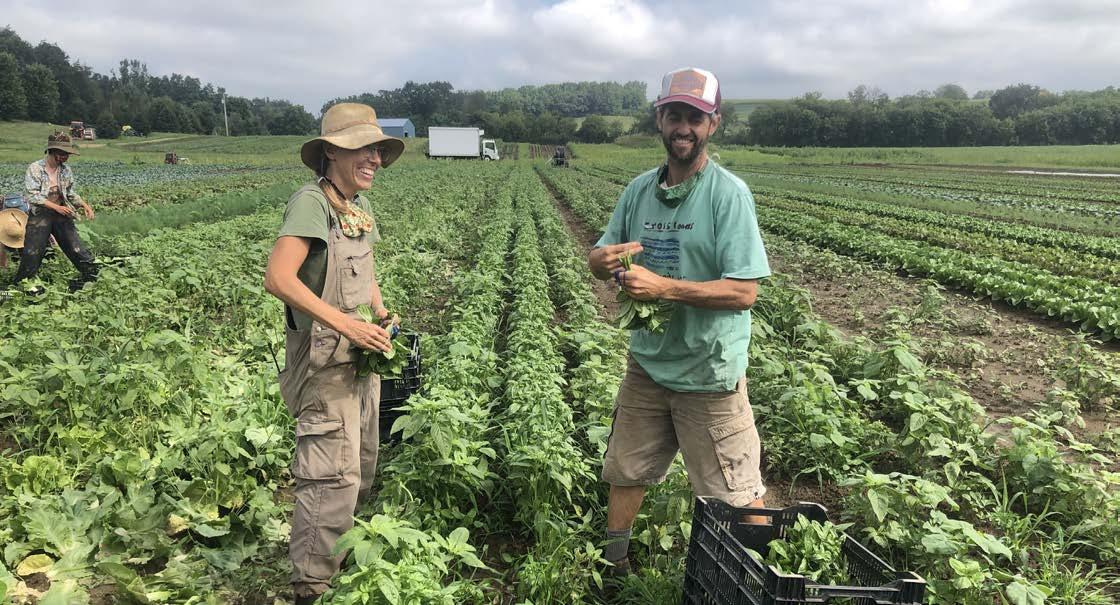
That was the easy part. Now Noltnerwyss had to find the money to fund the effort. Fairshare CSA Coalition committed to funding half of the project. To fund the other half, Noltnerwyss organized a GoFundMe campaign. “I was not prepared for what happened next,” she said. “In less than 24 hours we raised the rest of the money we needed—just shy of $10,000.” In total, her more than 800 CSA members put up over $20,000 to help. With all the extra cash, Noltnerwyss says they will increase support to the Mellowhood Foundation and contribute to Neighbors Helping Neighbors, an organization that provides food, clothing and relief services to those in need in the Mt. Horeb area.
Contradictions in Madison’s progressive bubble have come into sharp focus during the Black Lives Matter protests. Food insecurity is one of these glaring injustices, and the Madison community as a whole has serious work to do to create a place where all are provided-and cared-for. Noltnerwyss hopes the Meadowood project is a start. “Everyone deserves high-quality, healthy food,” she says. “This (seems) like a tiny, concrete step in that direction.”
EDIBLEMADISON.COM 5
“…Everyone deserves high-quality, healthy food.”
- Cassie Noltnerwyss
Cassie and Mike Noltnerwyss of Crossroads Community Farm harvest basil for their CSA members.
EL SABOR DE PUEBLA: REFLECTIONS ON A PANDEMIC
Imagine it’s a sunny Friday afternoon in early fall. The air is still warm and the anticipation of a weekend on the isthmus is palpable. Beer gardens are rolling out their chairs and tables, State Street’s bars are abuzz with groups of people meeting after work, and restaurant workers are busying themselves for a long night.
Alas, in pandemic times, all that feels far away. Those simple pleasures of a weekend spent eating, drinking and taking in the joy of the community aren’t quite the same. There’s an ache that comes from the lack of simple moments we thought would always be there: Badger games, beers after work, a dinner with friends. It’s only now that our options are limited that I realize how important these little things are. So, in the midst of this weird fever dream of a year, when I stumble upon a simple joy—like an excellent taco, for instance—it means that much more.
El Sabor de Puebla is an east side favorite located next to East High School on 4th Street. On a sunny Sunday afternoon I made my way over—masked up and sanitizer at the ready. I ordered three pastor tacos and a Coke and took them to the outdoor tables to sit and eat. As I tucked into the spicy, smoky pork, it occurred to me that this was one of the moments I had been longing for. The pandemic melted, leaving me with a sunny afternoon, a full belly and a moment of peace.
El Sabor de Puebla, owned and run by Reyna Gonzalez, who hails from the state of Puebla in South Central Mexico, has been serving farm-to-table, authentic Mexican food in Madison for five years. Reyna sources much of the restaurant’s produce from her brother Juan’s farm, Los Abuelos Farley Farm in Verona. The restaurant also makes its own masa from fresh corn, which gives its tortillas, picaditas and tamales exceptional flavor. Although the pandemic forced Gonzalez to close the restaurant this past spring, the location is now open for takeout, and delivery is available through Grubhub. Their tamales also are available at Willy Street Co-op, Santa Maria Grocery, Enrique’s Market, and Abarrotes Yuremi in Waunakee.

Tacos el Pastor, in all their glory, tucked in a to-go box, and the view inside El Sabor de Puebla on Madison’s East Side.
As the pandemic continues to rage, hopes of normalcy get pushed further and further down the road. In the meantime, visits to places like El Sabor de Puebla can help sustain small business and local agriculture and offer us something precious in return: the small moments of joy that keep us afloat, too.

6 • FALL 2020
RECIPE INDEX


Roasted Beet Sandwich with Fennel Salad & Feta 19
Vegan Shiitake Sandwich with Pickled Slaw & Edamame Hummus 20
Roasted Carmen Pepper Pimento Grilled Cheese with Sweet Onions & Apple Butter 22
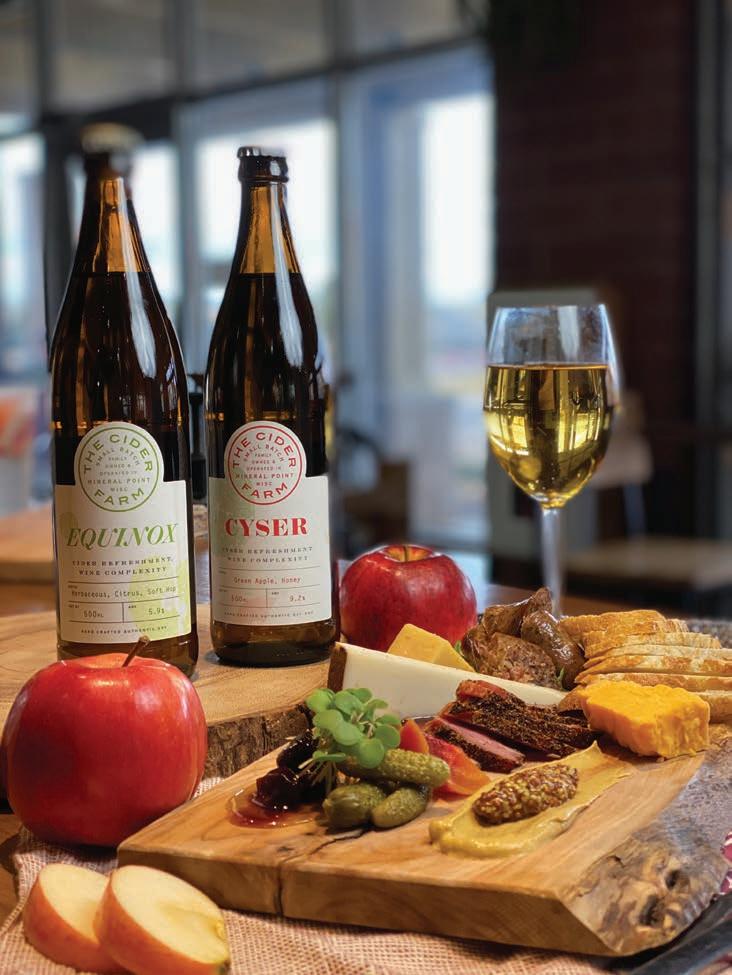
Goat cheese & Herb-stuffed Mini Peppers 26
Roasted Red Pepper Romesco Sauce 27 DIY Fire Cider 30
FALL
2020




8 • FALL 2020 To learn more and register: https://fyi.extension.wisc.edu/ediblestartup/ Attend an unlimited number of sessions for $25.00! GET
A Food & Beer Pairing Primer
You are craving a summery fruit tart—the joy of tender crust, the richness of pastry cream, the sweetness and perfect acidity of berries at the peak of the season—yet the barriers are potentially endless. Perhaps it’s the middle of winter and imported produce will not suffice, or maybe it’s the middle of summer and there is no way you are willing to turn on your oven, or maybe there just is not time to pull a tart together. You’re in luck: there’s a beer pairing for that! Even if you can’t have the tart itself, you can conjure the same delicious experience by pairing a bottle of fruit beer with a bit of fresh goat cheese. Voilà! The malt of the beer subs in for the crust, the goat cheese brings the rich dairy feel of pastry cream and that bright acidity reminiscent of perfect summer produce, and the fruit in the beer brings the, well, fruit on top.
CONJURE
pairing to evoke associations with a separate food
GENERAL EXAMPLE: Fruit beer and fresh goat cheese conjure a summer fruit tart, with maltiness as crust, goat cheese as custard, and the beer’s fruit as garnish.
SPECIFIC EXAMPLE: New Glarus Raspberry Tart and DreamFarm Goat Cheese.
EXPERIENCE: You’re instantly transported to a breezy summer evening, enjoying the bounty of the season any time of year.
 JESS i CA JONES
JESS i CA JONES
NOTABLE EDIBLES
BETTER TOGETHER
Exciting pairings like this one happen when at least one of the items shifts in a profound way to offer a new experience that’s impossible when you have each item in isolation.

To get to that profound experience, you need to start with the basics, by matching the palate impact of the food and beverage. A low-impact food item, such as fresh spring salad, will be lost next to a high impact beverage, like a barrel-aged stout, and vice versa.
Once you have considered the overall impact of a food or beer you plan to pair, other important factors come into play. You either want to play off of something familiar, or shift the internal balance of the food or beer by using multiple pairing principles.
There are primary pairing types and secondary considerations that help make the pairings work. Often the best pairings bring multiple aspects into play. The primary pairing types are Contrast, Complement, Compound or Conjure, which work along with the secondary considerations of Cleanse, Cut and Cancel.
Beer makes a great partner to many things simply because it is carbonated. On the one hand, carbonation works to physically cleanse the palate, much like those cartoon scrub brushes in cleaning product commercials. Carbonation can fizz mouth-coating things like fat away, so your next bite of pizza or fish fry seems just as unctuous as the first, disrupting any diminishing returns. At the same time, carbonation also helps aromatize aspects of the paired item that would otherwise be muted or less available to your olfactory receptors. This is why most any beer, assuming there is not a clashing flavor in play, is a good companion for almost any food.
COMPOUND
pairing similar flavors to over-accentuate
GENERAL EXAMPLE: American Barleywine and aged tea. Both are deeply malty and fruity.
SPECIFIC EXAMPLE: Giant Jones American Barleywine and Matcha Tea Company 2003 Green Heart Aged.
EXPERIENCE : A fresh beer quality compounds in each, highlighting their fermented character, then the fruitiness of each compounds with flavors of dried pineapple and toasted coconut.
10 • FALL 2020
GENERAL EXAMPLE: Strong hoppy beer and dark chocolate cancels the bitterness and highlights new depths in each.
SPECIFIC EXAMPLE: Giant Jones Double IPA and Wm. Chocolate Hati, Kafupbo 80% Dark.



EXPERIENCE: The malt comes more into balance with toasted marshmallow and popcorn notes, and hops skew to almost ripe mango; the chocolate pushes towards black tea with bitter orange and watermelon complexity. Federally

EDIBLEMADISON.COM 11 CONTRAST pairing dissimilar flavors to highlight differences
800.362.3944 heartlandcu.org I can’t remember exactly when I became a member at HCU, but without ‘em, I wouldn’t be where I am today.” — Abe
Member-Owner
WI ❝ We’re here to help you get to where you want to be.
insured by NCUA.
W.,
Madison,
COMPLEMENT pairing flavor aspects that have synergy
GENERAL EXAMPLE: Stout or porter and nutty cheese. The synergy of toasted nut and chocolate flavors pulls those components to the foreground.
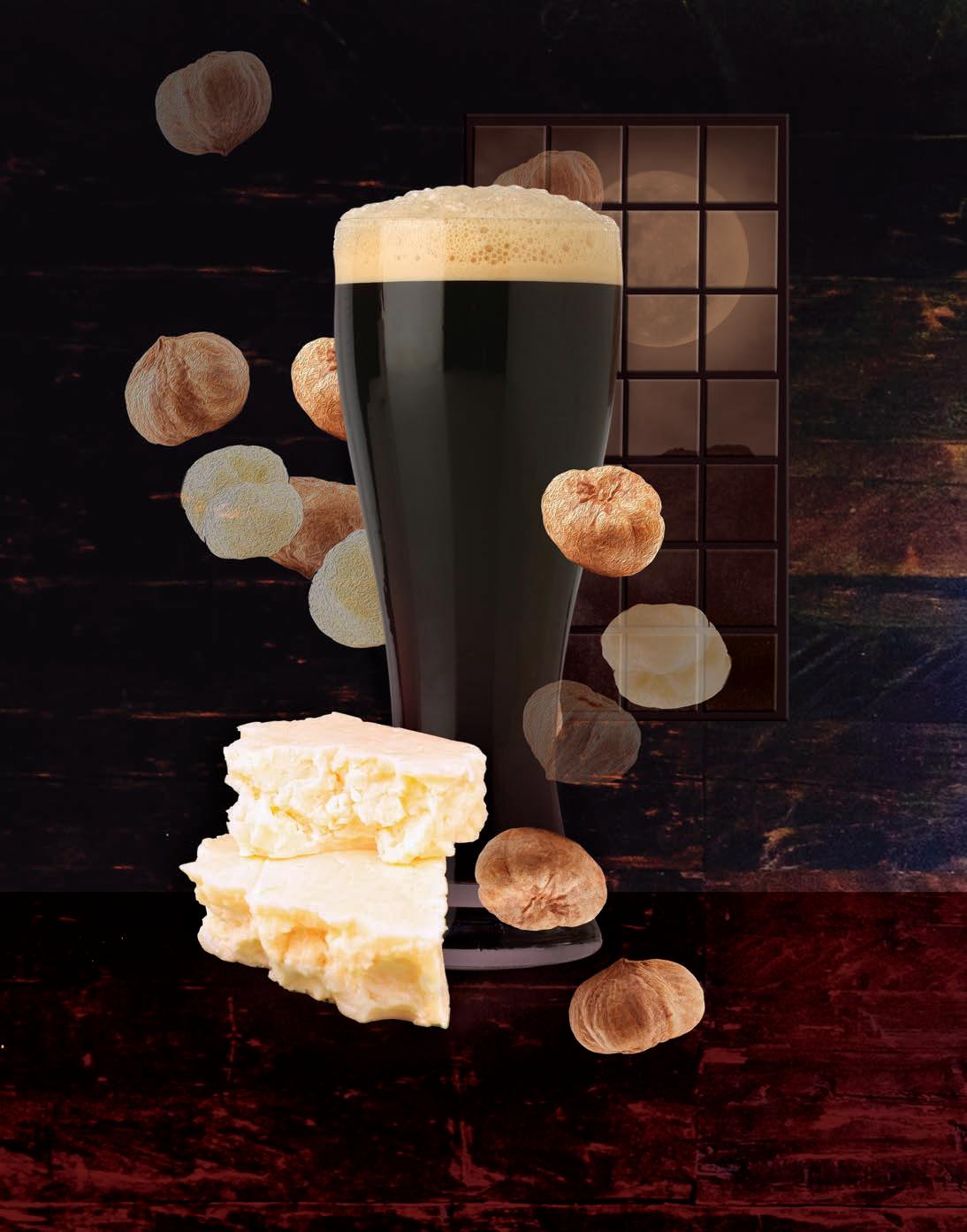

SPECIFIC EXAMPLE: Vintage Scaredy Cat Oatmeal Stout and Cedar Grove Monterey Jack.
EXPERIENCE: Everything becomes more indulgent, with beer and cheese seeming richer together than they ever do alone.
12 • FALL 2020
The experience of a cut is similar to the cleansing action of carbonation, as it helps keep your palate from being over-saturated by a particular aspect of the food. But rather than a physical reset, it is the stark difference of flavor that is in play. On the one hand, all beer has a degree of bitterness that can help cut fat or sweetness in food. On the other hand, all beer has a degree of sweetness that can cut bitterness or capsaicin heat in food.
Matching two similar aspects in beer and food can result in a canceling effect: the matched flavors cancel each other and end up dropping out of the experience. This often mutes bitterness more effectively than trying to lay a sweet element over top. The benefit of canceling is that it keeps the number of elements in play low, and allows you to over-exaggerate the elements of the beer and food that are not canceled. For instance, when you pair IPA with blue cheese or cheddar, matching the bitterness levels in the beer and cheese, you complement the fruitiness on both sides because you’re canceling the bitterness in both. The canceling is the mechanism that creates the experience, but it isn’t the interesting part: it’s how the fruit flavors compound as a result.
As you get a handle on matching impact, and considering how to cleanse, cut and cancel particular aspects of flavor, finding the profound shifts that make exciting pairings becomes more predictable. Proof of concept always requires smelling and tasting the actual pairing; luckily, each new day presents an opportunity to eat and drink amazing things together.

EDIBLEMADISON.COM 13
The key to pairing success is to match the palate impact of the food and beverage.
DISPATCHES FROM A BAKER OUTSIDE OF TIME
FOODWAYS MON i CA 0’CONNELL
Bakers are having a moment. Across the country and in our own towns, we are rising to the collective occasion like so much sourdough. We are sending thank-you cookies to essential workers, giving away celebration cakes to socially-distanced community members and raising funds for important causes. Some, like Washington, D.C.-based pastry chef Paola Velez, a lead architect of the locally executed and nationally successful bake sale Bakers Against Racism, are rightfully garnering media attention usually reserved for high-profile savory chefs. Bakers in and around greater Madison have been no exception. As fundraisers, spokespeople, and generators of goodwill and care during a time in need of both, bakers are having a moment. It is definitely, finally, the time of the baker.
And yet, I find myself feeling like a baker outside of time. A year ago this time I was making jam. I had new stores of strawberry rhubarb and red currant jelly on the shelf, a batch of vibrant peach saffron still cooling on the counter. I definitely identify as a seasonal baker—not always easy in a corner of the industry that tends to award vanilla, chocolate, and “sweet” the perpetual top spots in the flavor games. Each year I’ve tried to become more attuned to the subtleties of the southeastern Wisconsin year—and to reflect those subtleties in my recipes and flavor combinations. Creative immersion in the annual cycle has
been a culinary strategy but also one of emotional survival. It’s been a way of feeling intimately connected to and gracious in a place that can be less than hospitable to its Black populations. And by and large, this strategy has worked. I have courted the seasons and fallen in love with Wisconsin rhubarb, strawberries, elderflower, bramble berries, corn, plums, apples, hickory nuts and filberts, cranberries. I have found hopeful community and common ground among the many varieties of Wisconsin season geek.
However, there have been few temporal anchors in this long moment of COVID pandemic and (always) renewed assault on Black lives. With plans thwarted, business shuttered, safer-at-home precautions in place, and a concerned eye on protests here at home and across the country, I haven’t had the inspiration to bake how I usually do, let alone the market access. I’m realizing I’ve been thinking of “season” differently lately, and it’s directing my baking choices in ways that have little to do with time of year.
It feels like the season to be still, for instance. The season to tap into the wisdom of my predecessors. “We must love ourselves like spring,” author, doula, and Black feminist adrienne maree brown, reminds us. “We must love like fall, stripped down to the spare truth of each other.” It is the season, for me at least, to “feel the great circle of us holding each other.” Channeling the wisdom of Black women’s care work in the kitchen through my own family— in the hopes that I might extend it into
14 • FALL 2020

an uncertain future—is another, albeit more personal, way of baking against racism.
Curious about my shift of seasonal perspective, I asked other Black women about their own modes of resistance and flourishing—and how these get refracted through their kitchen work. What, I asked, do they bake when they need to feel grounded, resilient, or renewed?
Sylvia Aslakson, owner of Miss Ella’s Cake Bar, an appointment-only custom bakery, practices her kitchen work as a means of accessing her higher self and building the village she didn’t always have growing up. The joy that baking birthday cakes brings her is evident in each exuberant design. “It’s not about a specific flavor necessarily, it’s about seeing a kid light up,” she says. “When you are never celebrated, you can grow up thinking no one cares. Circumstances shouldn’t define whether we get celebrated or not.” With each and every birthday cake, Aslakson says, “toxic cycles that were created before you get to be routed in a new direction.”
Baking is sensory and tactile for Carrie Seward, founder of Lush Life Vegan Bakery. When she enters the kitchen, the “click” of the mixer switch flipping on drops her into another state. Her hands, which she considers her energy center, get busy—kneading dough for cinnamon rolls or stirring cake batter. It is through her hands that she is able to “channel unconditional love” into each item she
bakes. Seward’s bi-racial background informs her perspective on the way assumptions, perceptions, and ignorance can hinder authentic connection, but she sees cake as common ground: “Everybody loves cake! It’s the great leveler!” she says. “It’s not my job to educate people, but I try to make my cakes for everybody. I have many different kinds of customers from many different backgrounds. They all show up because of the love I put in.”
We don’t have to do this work professionally to understand baking as a space of active resistance and personal renewal. As an educator, writer, health advocate and founding CEO and President of The Foundation for Black Women’s Wellness, Lisa Peyton Caire doesn’t have as much time as she’d like for baking. Still, she notes, “Cooking has been the first love for many of the women in my family,” and the kitchen the heart center of every home. In addition to baked chicken and rice, greens and mac and cheese, Caire remembers sweet potato pie, cherry pie, and her mom’s peach cobbler among her family’s food traditions. When she does take the time to bake her organic, low-sugar version of her mom’s cobbler, Caire, “spirit-surrounded,” is able to re-center and reset. When baking “you are breathing in a different way, you are moving at a slower, more intentional pace, your mind is clear,” she says. “And you’ve created something that allows you to transfer healing to your family and acknowledge your roots.”
16 • FALL 2020
My mom and the Black women in my community remind me that what you bake against always, essentially, comes down to who you’re baking for.
For me, at least right now, that acknowledgement is taking the form of lemon meringue pie. Apart from maybe the local eggs and butter, this classic has little direct connection to the Wisconsin terroir, but an ice cold slice is the perfect thing to eat on a warm summer evening while social distancing. It’s also a dessert I remember my mother making with joy and natural ease. Young me marveled at how she proceeded with no written recipe, how her slender fingers so deftly worked butter into flour for luxurious flakes, and how her piledhigh meringue sometimes toppled (!) but never wept.
Now, I marvel at how a woman continually navigating complicated and often inhospitable terrain worked to make a way for us. She leveraged her kitchen work to carve out spaces of care and delight—sometimes even in the midst of difficulty and upheaval. When I re-enter something that feels like a regular timeline and am again baking in sync with what is perfectly ripe, this ability is what I’ll want to bring with me. My mom and the Black women in my community remind me that what you bake against always, essentially, comes down to who you’re baking for.

EDIBLEMADISON.COM 17
REAL FOOD. REAL LOCAL. FARM-TO FREEZER stock up on frozen favorites COOK FRESH weekly meal kit delivery and pick-up CURBSIDE PICK-UP order from our menu online (air-fives included) 2433 University Avenue | pastureandplenty.com We are grateful for the opportunity to help you eat well, support local farmers and makers, and protect local jobs. Supporting a strong, resilient local food system is critical for our community’s health and it nourishes you too.
LAUREN RUDERSDORF
PLANTPOWERED SAND
WICHES
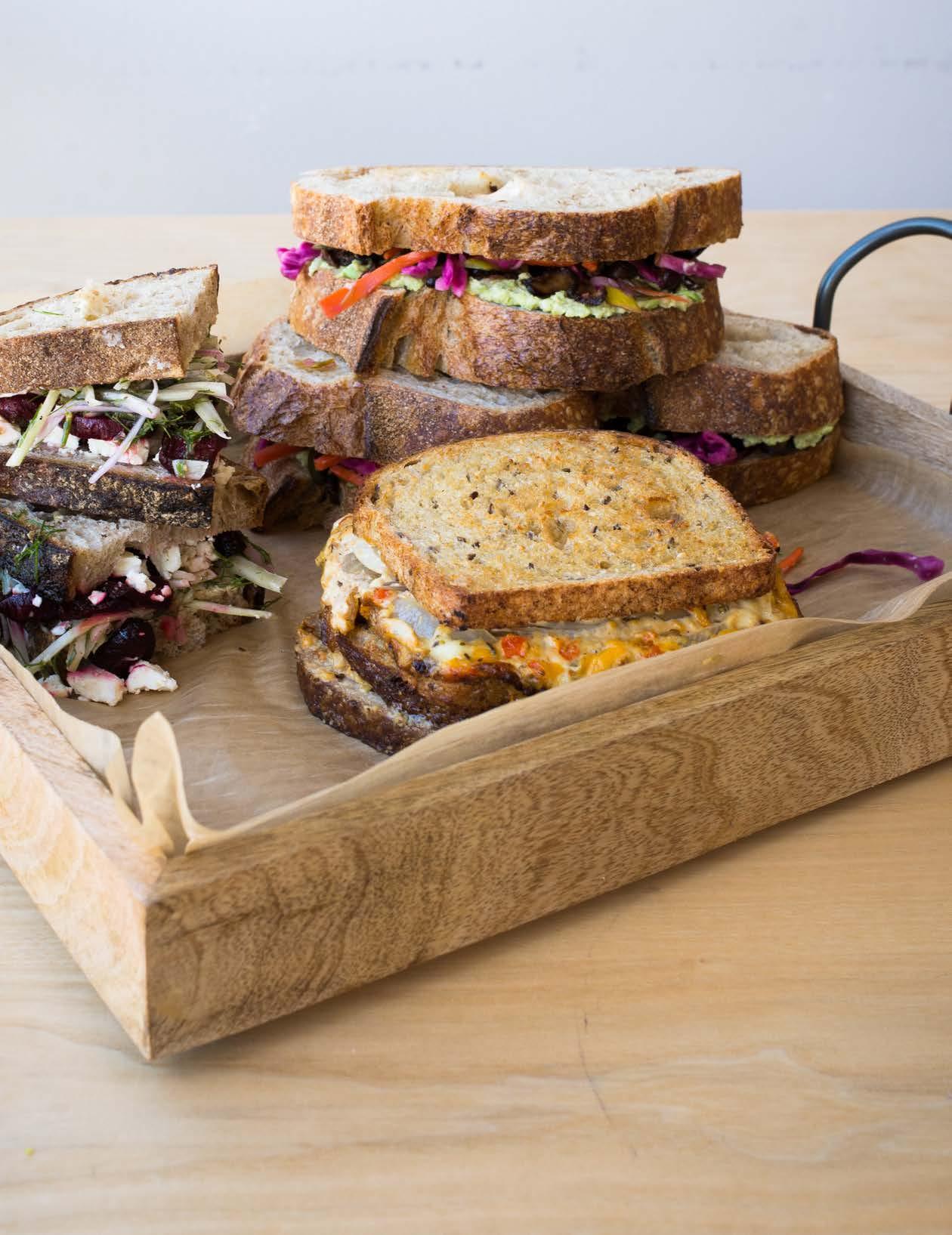
-
COOK AT HOME
Roasted Beet Sandwich with Fennel Salad & Feta
DIRECTIONS
1. Preheat oven to 400°F.
Recipe
by Lauren Rudersdorf of Raleigh’s Hillside Farm and The Leek & The Carrot
Any season of the year beets and fennel are my absolute favorite combination, but there is something really special about this recipe in the fall when there are lots of storage beets on the horizon and you want to get inspired with beets in a new way. Plus, the rich earthiness of the beets plays well with the bright complex flavor of the fennel. A little citrus makes things really pop!
makes 4 sandwiches prep time: 20 min cook time: 20 min
INGREDIENTS
2 Tbsp olive oil
2 large beets (or 3 medium), peeled and cut into ¼-½-inch slices
1 tsp Kosher salt, divided
¼ tsp freshly ground black pepper
½ medium red onion, thinly sliced, divided
3 Tbsp lime juice
1 tsp Kosher salt, divided
1 medium fennel bulb with fronds
2 Tbsp capers, finely chopped
¼ cup olive oil
8 slices sourdough bread, toasted
¼ cup mayonnaise
¼ pound feta, sliced
2. Heat oil in a large cast-iron (or other heavy, oven-proof) skillet over medium heat. Add beets in a single layer, sprinkle with ½ teaspoon salt and pepper; cook for 3 to 4 minutes without moving until beets are seared and browned, but not burnt.
3. Gently flip beets and place in a preheated oven. Cook until tender, 10 to 15 minutes . Unless your skillet is very large, you will do this in two batches or in two skillets.
4. Meanwhile, prepare your fennel salad. Mince half the red onion and combine with lime juice and remaining ½ teaspoon Kosher salt in a medium bowl.
5. Separate the fennel fronds and bulb. Finely chop about half the fronds (you want ¼ -½ cup total). Core and thinly slice bulb. Toss the fronds, bulb, remaining sliced onion, capers and olive oil with the onion-lime mixture. Drizzle with olive oil and toss once more.
6. Spread mayonnaise on half the pieces of toast. On the other half, equally divide the feta slices onto the bread. Top feta with sliced beets and pile on the fennel salad.
7. Top sandwiches with mayo toast.
EDIBLEMADISON.COM 19
BLT season may be on its way out, but fall is a delicious time of year for sandwiches packed full of veggies from our gardens and CSA baskets. These three sandwiches won’t have you missing meat at all.
Photos by Tracy Harris
Vegan Shiitake Sandwich with Pickled Slaw & Edamame Hummus
 Recipe by Lauren Montelbano of The Vibrant Veg
Recipe by Lauren Montelbano of The Vibrant Veg
Chef Lauren Montelbano of The Vibrant Veg promotes locally-sourced, plantbased fare through cooking classes, nutrition consultations,and private chef and catering services.
It is best if you have the forethought to prepare the slaw a couple of days prior to making the sandwich, but if you can’t help yourself and need to eat it right away (like I did), I assure you, it will still be delicious. The edamame hummus and gochujang aioli can also be made in advance.
Makes 4 sandwiches
Prep time: 45 min Cook time: 20 min
FOR PICKLED VEGETABLE SLAW:
2 cups purple cabbage, thinly sliced
1 cup carrot, julienned
1 cup daikon radish, julienned
2 jalapenos, sliced in rings (pith and seeds removed)
2 scallions, sliced
2 cloves garlic, sliced
1 Tbsp grated fresh ginger
1/3 cup chopped cilantro or cilantro stems (I like to use the stems because they add all the flavor, which allows me to reserve the leaves for garnishing)
1 cup rice vinegar
1 cup water
1/2 cup evaporated cane juice 2 tsp salt
DIRECTIONS
1. Combine cabbage, carrot, daikon, jalapenos, scallions, garlic, ginger, and cilantro in a medium sized bowl.
2. Prepare the brine by combining water and vinegar in a small pot and bringing it to a low boil. Add in the sugar and salt, and stir until it has dissolved into the liquid.
3. Remove from the stove and pour the liquid onto your vegetables.
4. Cover your bowl with plastic wrap and poke a few holes in it. Place in the fridge to cool. This will allow the slaw to cool while keeping in the flavor. Let chill for (ideally) 24 hours and up to 7 days.
FOR MARINATED SHIITAKE MUSHROOMS:

1 pound shiitake mushrooms, destemmed and thinly sliced
¼ cup grapeseed oil
¼ cup soy sauce or tamari
6 Tbsp rice vinegar
2 Tbsp hoisin sauce
DIRECTIONS
1. Remove stems and thinly slice shiitake mushrooms; place in a bowl.
2. Add all other ingredients and toss with the mushrooms. Marinate for at least 20 minutes (the perfect amount of time to prepare the edamame hummus and gochujang aioli, and let the oven preheat).
3. Preheat oven to 400°F.
4. When the mushrooms are done marinating, place them on a lined baking sheet and bake them in the oven until crisping at edges and cooked through, 15 to 20 minutes, stirring halfway through.
5. After 20 minutes, pull them from the oven and get ready for flavortown!
20 • FALL 2020
FOR EDAMAME HUMMUS:
2 cups edamame, thawed if frozen
1/3 cup lemon juice
1/4 cup tahini
1 tsp toasted sesame oil
1 Tbsp white miso
Pinch of salt
6 cloves garlic
2 Tbsp grapeseed oil
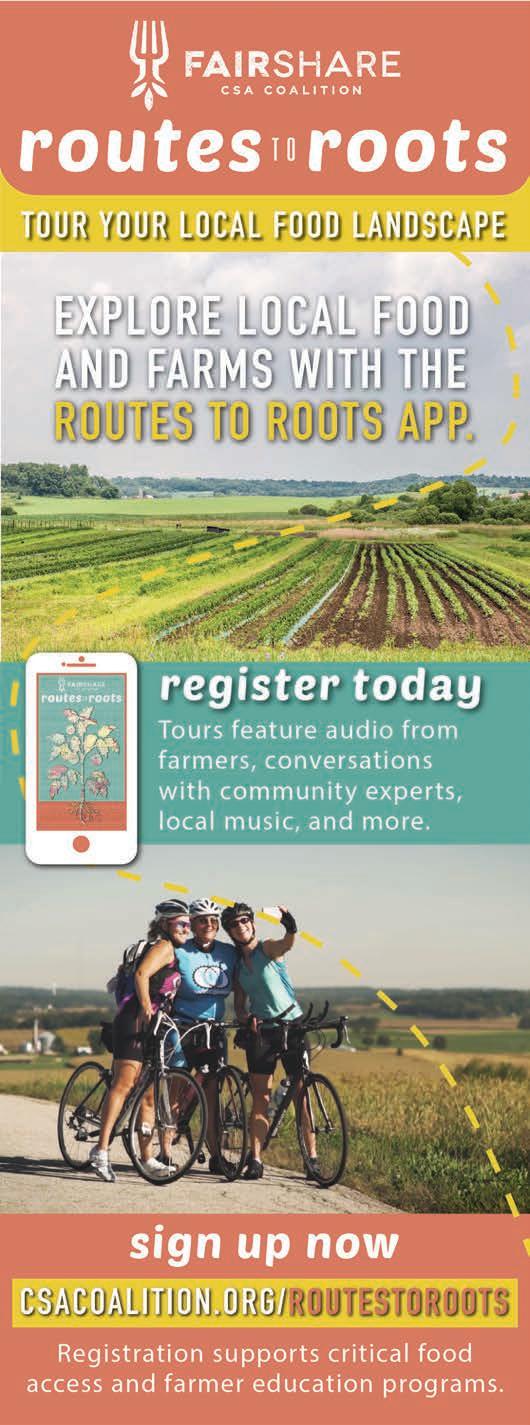
DIRECTIONS
1. Roast garlic in a small pan on medium-high heat with grapeseed oil or other high heat oil. Flip cloves after 4 to 5 minutes, when one side begins to brown. When both sides are nicely roasted, remove cloves from the pan and place in a food processor. If there’s leftover oil in the pan, reserve this and use it at a later time for a different recipe.
2. Place all other ingredients in a food processor and begin processing until smooth.
FOR GOCHUJANG AIOLI:
1/2 cup vegan mayonnaise or aioli
1 tsp gochujang
DIRECTIONS
1. Mix aioli and gochujang in a small bowl. Boom, done!
INGREDIENTS
8 slices sourdough toast or
4 split ciabatta rolls
Now the moment we’ve all been waiting for....the sandwich assembly! Lightly toast your bun or bread. Slather one side with the aioli and the other with the hummus. Place the mushrooms on the hummus and top with the pickled slaw and more fresh cilantro if you like. Add the top and it’s ready to enjoy!
EDIBLEMADISON.COM 21
Roasted Carmen Pepper Pimento Grilled Cheese with Sweet Onions & Apple Butter

INGREDIENTS
Recipe by Tommy Gering of Casetta Kitchen and Counter
Anyone who’s been to Casetta on the square knows that those folks know how to make a mean sandwich. Take your grilled cheese game to the next level with this delectable recipe from co-proprietor Tommy Gering.
Carmen peppers come into season during late summer and hang around through fall. They are a thin-skinned Italian sweet pepper. They have a wonderful edible skin so you can roast them without taking the time to peel them.
Don’t have carmen peppers? Substitute pimento or red bell peppers.
Makes 4 sandwiches
Prep time: 20 min
Cook time: 35 min
DIRECTIONS
1. Preheat the oven to 450°F.
2. Melt 2 tablespoons butter over medium low heat. Add the onion, season with salt and pepper and cook slowly until the onion is very soft, 15 to 20 minutes. We are not looking for any color—just cook until the onion starts to melt and the juices form a nice sauce with the butter.
3. While the onion cooks, toss the peppers and garlic with the oregano and oil in a medium bowl. Season with salt and spread out on a baking sheet. Roast in the oven until the peppers start to char and the skin blisters, 10 to 15 minutes.
4. To make the pimento cheese-inspired filling, let the peppers cool and then chop them up into small pieces. Return them to the bowl you prepared them in. Add mayonnaise, cheddar, mozzarella, pickled hot peppers, and mustard. Stir to combine, and season with salt and pepper.
5. To assemble the sandwiches, spread butter on the outside of each piece of bread. Lay the bread butter side down on a baking sheet. On four of the pieces of bread, spread what’s left of the butter and a spoonful of the onions. Finish with a scoop of the cheese and pepper sandwich filling. Top with the other slice of bread, butter side facing out.
6. In a large non-stick pan, grill the sandwiches over medium heat until they are golden brown on the outside and the cheese is hot and melted on the inside, flipping halfway through.
7. Let rest briefly before slicing and serving.
22 • FALL 2020
6 Tbsp softened butter, divided 1 whole white or yellow onion, thinly sliced Salt Pepper 4 carmen red peppers, seeded, cut into strips 3 cloves garlic, thinly sliced 1 Tbsp dried oregano 1 Tbsp neutral oil, like vegetable or sunflower 1/2 cup mayonnaise 1 cup Hook’s 1-year cheddar, grated 1/3 cup low-moisture mozzerella, grated 3 Tbsp pickled hot peppers, chopped 1 Tbsp Dijon mustard 8 pieces white bread Apple butter
Photos by Tracy Harris
Sweet Peppers
are one of my favorite vegetables

DIG IN DAN i L i ND
5,000
Jalapeno 150,000 Habenero

<1,000
sweet peppers
Sweet Peppers
1,000,000
0 2,000,000
50,000 Cayenne 150,000 Carolina Reaper
SCOViLLE UNiTS
3,000,000 + pepper spray
are in the same genus as hot peppers, but have little or no capsaicin content, the chemical that causes spiciness in hot peppers. Capsaicin is measured in Scoville Units, with sweet bell peppers at 0 on one end of the spectrum and Carolina Reaper hot peppers at 2,000,000 on the other end. Peppers with 1,000 or less Scoville Units are considered sweet peppers, and fall into these basic categories:

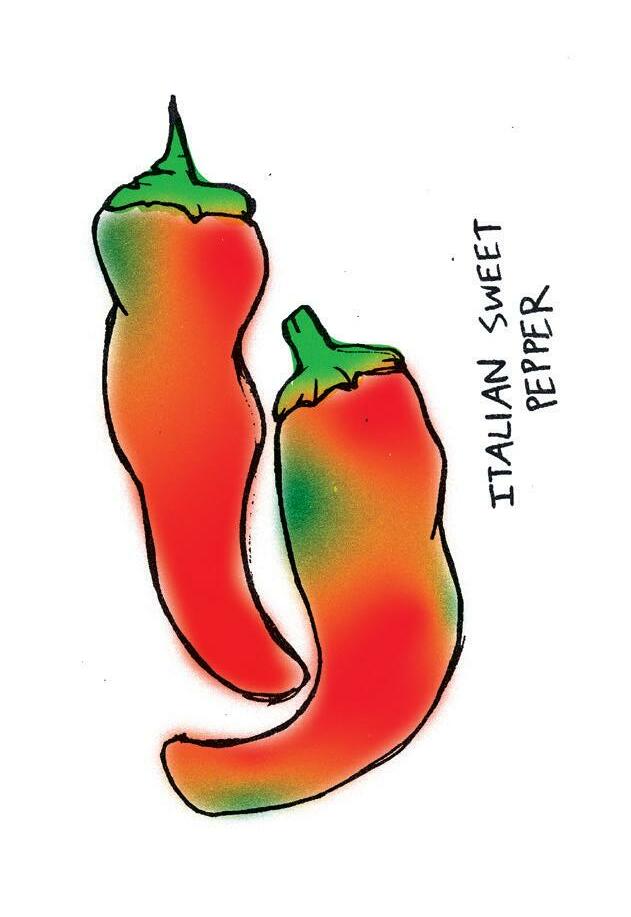
Bell Peppers

Blocky, thick-walled peppers of varying colors when ripe, with no heat whatsoever.
sweetPeppersPaprika
Pimento Peppers
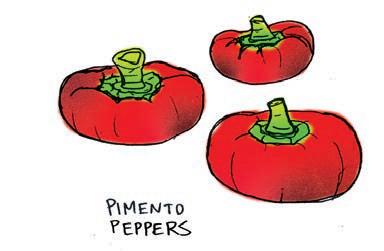
Small, usually squat, thick-walled peppers that are super flavorful and excellent pickled or roasted (or roasted and pickled). Some varieties have a bit of heat, but not much.
And straddlers
Italian peppers
Elongated and pointy, with lots of variation, from the skinny, wrinkly pepperoncini types to the smoothwalled bull’s horn types. Primarily used for frying, roasting, or pickling, but many are also good fresh.
A buyer’s note:
Mostly developed in Eastern Europe, these are traditionally used for drying and grinding into paprika powder, but are also excellent roasted or sautéed. Different varieties have different levels of spiciness – from moderate to almost no heat..
Then there are some sweet peppers that defy categorization, like shishitos, sweet bananas, and some new-fangled ones (thanks to creative seed breeding) like mini sweets and heatless jalapenos and habaneros.
In almost all varieties of sweet peppers, green peppers are simply unripe peppers that are picked before they develop their color. Because of this, green peppers have less nutrition (half the vitamin C as a red pepper!) and lower sugar content (a.k.a. flavor) than their colorful ripe incarnations. Why, then, are green bell peppers the best-selling pepper on the market? Probably because they’re always the cheapest! They can be harvested far earlier than ripe ones, making them cheaper to grow. I’ll argue that you get what you pay for, and I for one would rather buy one delicious beautiful-colored pepper than two bland green ones.
24 • FALL 2020
Illustrations by Michael Sambar
Here are just some of the ways you can use them:
Speaking of buying peppers, consider ordering a case of seconds from a grower at your farmers’ market to freeze for use all winter. (There’s no need to blanch them.) It’s one of the best investments you can make!
raw in salads or with dip • raw in salsa or fresh chutney• pickled • roasted whole under broiler, on a grill, or over gas stove flames • sliced and roasted in oven with oil, garlic, and fresh herbs stir-fried with other veggies • sautéed and simmered in pasta sauces, soups, stews, and chili • chopped and sautéed with onions and garlic as a sofrito base for rice or beans

EDIBLEMADISON.COM 25
Photo by Jim Klousia
Goat Cheese & Herb-stuffed Mini Peppers
serves 4-6 prep time: 20 min cook time: 30 min
Directions
1. Preheat oven to 375° F.
2. In a medium bowl, mix together chevre, herbs, lemon juice/zest, garlic, 2 Tablespoons of the olive oil, capers, salt and pepper. Pick out a rimmed sheet pan or a glass or ceramic pie dish or casserole pan that will fit all the mini peppers.
3. Set each mini pepper on a cutting board and carefully make a lengthwise slit down the center of the side facing up. Use your finger near the stem end to pry each slit open and stuff each pepper with about a heaping teaspoon of filling. Repeat until filling is gone and all the mini peppers are stuffed.
4. Place each pepper slit side up in your pan, drizzle with remaining olive oil, and roast for 25-30 minutes, until peppers are softened.
Ingredients
1 pint mini peppers 8 oz chevre
½ cup loosely packed chopped mixed fresh herbs (chives, parsley, basil, thyme, oregano, rosemary, etc.)
Juice and zest of 1 small lemon
2 cloves garlic, minced
4 Tbsp olive oil, separated 2 Tbsp capers
Sea salt & black pepper to taste
Suggestions
Serve hot or room-temperature as an appetizer, side dish, or a vegetarian main course with creamy polenta and garlicky white beans or chickpeas.

26 • FALL 2020
Roasted Red Pepper Romesco Sauce
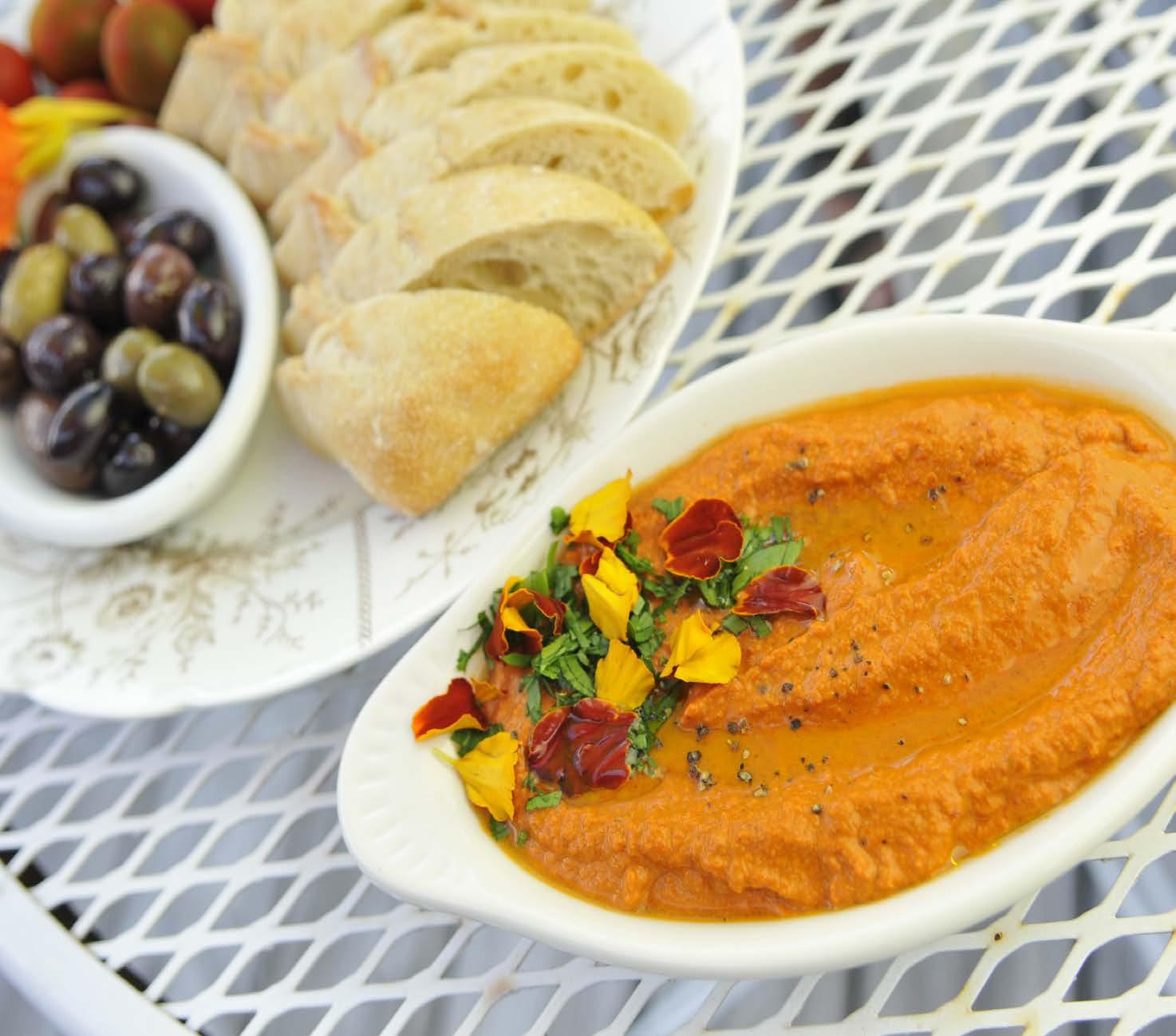
makes 2 ½ cups prep time: 15 min cook time: 15 min
Directions for romesco sauce
1. Place toasted nuts, garlic, tomato paste, paprikas , salt, pepper, and sherry vinegar in food processor and process to a chunky paste. Add toasted bread and seeded/skinned
Ingredients
1 thick slice of baguette, sourdough, or gluten-free bread, toasted and broken into pieces
2 medium red bell peppers or 3 medium red Italian roasting peppers, roasted (see instructions)
3/4 cup raw hazelnuts (or almonds or walnuts or combo), toasted and skinned
2 large cloves garlic
3 Tbsp tomato paste (or 2 whole roma tomatoes, roasted and skinned)
1 tsp smoked paprika
¼ tsp hot paprika or 1/8 tsp. cayenne
½ tsp sea salt and black pepper to taste
2 to 3 Tbsp sherry vinegar
6 Tbsp olive oil
Directions for roasting peppers
1. Pick a thick-walled blocky bell type or smooth tapered roasting-type pepper for uniform roasting and easy peeling.
2. Place whole on hot grill or under broiler or directly over the flames of a gas grill for a couple minutes, until the side closest to the heat starts to
Photos by Jim Klousia
LAURA POE MATHES
Breathing Fire Into Fall
This past summer certainly looked different than any before, but on the bright side, many of us got to spend extra time in the garden. This may have left us more tired than summers of the past, but it also left us with an abundance of produce to use in new ways. And no use of produce may be more suited to these times than making herbal remedies—turning garden spoils or farmer’s market hauls into something healing and nourishing.
Fire Cider is one such remedy. I like to think of Fire Cider as the ultimate concoction to capture the heat of summer, storing it up for those cooler months, when our bodies really need it. This herbal medicinal is an infusion of hot and pungent herbs, vegetables, and fruits into raw apple cider
vinegar. After four to six weeks of infusion, the liquid is strained off and a bit of honey is added at the end. Fire Cider is taken in small doses, either daily as a tonic or on an as-needed basis, whenever you feel your body could benefit. It is typically meant to support immune function and digestive health.
The recipe for Fire Cider has been passed around for ages, with no clear origin. Renowned herbalist Rosemary Gladstar popularized today’s best-known version. Her recent book, “Fire Cider!,” is entirely dedicated to this elixir and offers an in-depth look at the history and benefits of this simple remedy, as well as several
variations on the recipe.1 While Fire Cider has been used for generations, it has gained popularity in the past several years, as many look to take a more active role in their health.

Though Fire Cider may be a folk remedy, there is plenty of scientific evidence to support the therapeutic benefits of each of its ingredients. The mighty, pungent trio of garlic, onion, and horseradish all contain anti-microbial and anti-inflammatory compounds, plus they’re rich in sulfur, helping to promote detoxification and production of glutathione, the body’s “master antioxidant.”2,3 Turmeric, ginger, and hot peppers have antimicrobial, anti-inflammatory, and immune-enhancing prop-

NOURISH
28 • FALL 2020
erties as well.4,5,6 Citrus and rose hips bring their high vitamin C content and flavor.7 Raw honey,also high in antioxidants, soothes the throat, and adds a bit of sweet to cut the tart and spice of the vinegar infusion8. Ginger, along with many of the other ingredients, has been linked to digestive wellness, and may soothe indigestion, decrease nausea, promote a healthy microbiome, and aid in healthy stomach acid production.5
Apple cider vinegar, when left raw and unfiltered, is a folk remedy all its own, a nourishing and probiotic food full of beneficial bacteria, enzymes, and acetic acid that promote many aspects of health, including improved digestion, enhanced immune function, and balanced blood sugar. It also has antioxidant and antimicrobial properties and has been credited as an aid in weight management. 9
With all of these potential benefits packed into one concoction, it is easy to see how Fire Cider has come to hold near-mythical status among those familiar with natural remedies. It has a special place in my heart for its strong flavor, the potent combination of ingredients, and its long tradition of use as a tonic.


Free Fire Cider!
In 2012, Massachusetts-based Shire City Herbals trademarked the name Fire Cider, creating quite a controversy in the herbalist community. Producers were forced to find alternative names for a formula they felt belonged to everyone. If you have seen “Fire Tonic” or “Dragon Tonic” on the shelves in the past few years, this was simply the Fire Cider formula under a different name. After a great deal of pushback from natural health enthusiasts, this trademark was overturned earlier this year, and the original name can now be used by all.
EDIBLEMADISON.COM 29
DIY Fire Cider
Makes about 3 cups
Prep time: 20 min
Ingredients
1 cup chopped yellow onion
1/4 cup grated fresh ginger
1/4 cup grated fresh horseradish root
8-10 cloves garlic, minced
2 hot peppers, such as jalapeno or habanero, diced
2 Tbsp fresh turmeric, grated, or 1 Tbsp dried turmeric
Zest and juice of 1 lemon
Zest and juice of 1 orange
3 Tbsp dried rose hips
2 to 3 cups raw apple cider vinegar
1/4 cup raw honey or to taste (omit completely if on a low-sugar diet)
Optional additions
2 to 3 Tbsp rosehips, fresh rosemary, thyme, and/or oregano
Directions
1. Pack the prepared vegetables, citrus, and herbs into a clean quart-sized glass jar. Using food-safe gloves will help you avoid getting hot pepper juice where you don’t want it, and prevent your hands from getting stained with turmeric. Add in the apple cider vinegar to cover the herbs, filling to the band of the jar.
2. Cover the jar with a non-reactive plastic lid, or a metal lid with a piece of parchment between the lid and jar to prevent the lid from rusting. Seal tightly and shake for several minutes.
3. Label and date the jar with the day you made it. Set aside for 4 to 6 weeks, shaking for a minute or two every few days to fully infuse the vinegar with the herbal goodness.
4. After 4 to 6 weeks, pour through a mesh strainer over a bowl to strain out all solids, reserving the liquid. Squeeze solids with gloved hands to extract as much vinegar as possible. Return the liquid to the jar.
5. Add raw honey to the jar and whisk thoroughly to dissolve. Cover and store in the refrigerator, where it will keep for about one year.
Suggestions
As a tonic, take ½ to 1 tablespoons one to two times per day. If you are new to using apple cider vinegar medicinally, start with 1 teaspoon and work up to this amount.
For those with sensitive stomachs or teeth, be cautious and use smaller quantities, as it is quite acidic. I recommend diluting it in a bit of water to help mitigate the acidity.
My favorite optional addition is rose hips, but rosemary, thyme, and oregano also make great add-ins for their flavor and medicinal properties. It’s fine to add more or less honey to your taste or omit it completely If you require a low-sugar diet.
Try a sip of Fire Cider before or after meals as an aid to digestion. Fire Cider can also be added to salad dressings, sauces, dips, and marinades. Heck, I’ll even take it in a cocktail, such as a paloma, greyhound, or Bloody Mary.

You can also make a flavorful alcohol-free mocktail using Fire Cider, some sparkling water, a dash of cocktail bitters, and a touch of extra honey.
SOURCES 1. Gladstar, Rosemary. Fire Cider!: 101 Zesty Recipes for Health-Boosting Remedies Made with Apple Cider Vinegar. Storey Publishing, 2019. 2. Tripathi, P C, and K E Lawande. “Therapeutic and Medicinal Value of Onion and Garlic.” Jan. 2006, doi:DOI: 10.13140. 3. Marzocco, Stefania, et al. “Anti-Inflammatory Activity of Horseradish (Armoracia Rusticana) Root Extracts in LPS-Stimulated Macrophages.” Food & Function, vol. 6, no. 12, Dec. 2015, doi:10.1039/c5fo00475f. 4. Labban, Louay. “Medicinal and Pharmacological Properties of Turmeric (Curcuma Longa): A Review.” Int J Pharm Biomed Sci., 2014. 5. “The Amazing and Mighty Ginger.”
Herbal Medicine: Biomolecular and Clinical Aspects, Second Edition, by Iris F. F. Benzie and Sissi Wachtel-Galor, 2nd ed., Taylor and Francis, 2011, www.ncbi. nlm.nih.gov/books/NBK92775/.6. Yu, R et al. “Modulation of select immune responses by dietary capsaicin.” International journal for vitamin and nutrition research vol. 68,2 (1998): 114-9. 7. Lykkesfeldt, Jens et al. “Vitamin C.” Advances in nutrition (Bethesda, Md.) vol. 5,1 168. 1 Jan. 2014, doi:10.3945/an.113.005157. 8. Lykkesfeldt, Jens et al. “Vitamin C.” Advances in nutrition (Bethesda, Md.) vol. 5,1 16-8. 1 Jan. 2014, doi:10.3945/an.113.005157.
9. Johnston, Carol S, and Cindy A Gaas. “Vinegar: me-
dicinal uses and antiglycemic effect.” MedGenMed : Medscape general medicine vol. 8,2 61. 30 May 2006. Disclaimer: This information is provided for informational purposes only and is not intended to substitute for the advice provided by your doctor or other health care professional. You should not rely upon or follow information in the above article for decision-making without obtaining the advice of a physician or other health care professional. The nutritional and other information in this article are not intended to be and do not constitute health care or medical advice.
30 • FALL 2020
Photos by Tracy Harris




EDIBLEMADISON.COM 31 1 2 3 WILLY EAST: 1221 Williamson St. Madison, WI 1 WILLY WEST: 6825 University Ave. Middleton, WI 2 WILLY NORTH: 2817 N Sherman Ave. Madison, WI 3 Check out any of our three locations. Everyone Welcome! Information about our COVID-19 precautions, see www.willystreet.coop/coronavirus. At Willy Street Coop, over 1/3 of the products the Coop purchases are local! Buying local keeps money circulating in local communities, which helps keep our neighbors employed and more financially secure.

32 • FALL 2020
The Herbalist’s Path
by Hannah Wente
Wildwood Institute: Training a New Generation of Herbalists
Drive past West Towne mall in Madison, alongside farm fields and new development, to a secret garden. Walk under an archway down a gravel path lined with ferns and milkweeds. Circular paths shoot out from the main path encompassing native Wisconsin herbs. Even through a protective mask, you can notice an aroma on the breeze. Birds chirp. The land features a gentle mix of sun and shade and overlooks the Ice Age Trail. Tiny pink flowers, marshmallow plants and yellow St. John’s Wort blossoms dot the landscape.
Kathleen Wildwood’s home in Verona is the Wildwood Institute, an herbalism school she founded in 1996, when few herbalist schools existed in the Midwest.

EDIBLEMADISON.COM 33
The front half of the house functions as a working apothecary with an indoor classroom on the second floor. An outdoor classroom covered by a large tent used from May through October. Wildwood studied pre-med in college, but “I came to the realization that conventional medicine wasn’t really about healing,” she says. She switched her major to psychology and practiced social work for ten years.
While researching options for dealing with her own health problems, she developed an interest in herbalism. “It’s the ultimate interdisciplinary study,” she says. “It combines science, nature, history and tradition, and a sense of being part of something bigger.”
In addition to individual consultations and herbal product sales, Wildwood’s most popular offering is a one- to three-year herbal apprenticeship program, which she started in 2003. About a dozen students from the Upper Midwest start the program each spring, with classes held one weekend per month.
Students rotate through discussions, lectures and herb walks. Early on in the program they learn about body systems and useful herbs for each system. They learn how to identify herbs growing around them by sight, taste and smell, as well as how and when to use them. They also learn how to make preparations in the Wildwood Institute apothecary, a cool, clean room lined with shelves of mason jars. Preparations include infused oils and tinctures—herbs soaked in alcohol for several weeks.
Graduates of the herbalist apprenticeship program go on to craft herbal remedies for themselves or family members, or incorporate what they’ve learned into existing roles as pharmacists, physician assistants, nurses and physicians. Others, like Stephanie Mullis, start herbal businesses.

34 • FALL 2020
“Herbalism is everything, It’s nutrition, health, wellness, it’s the land, it’s the herbs themselves.”
Photos by Tracy Harris
Apprentice to Owner
Mullis searched for in-person herbalist training in the Midwest for years. She was relieved to finally find a school in the Madison area, and completed Wildwood Institute’s one-year apprenticeship in 2019. “It was so great to connect with people and get to work with herbs hands-on in a learning environment,” she says.
She started practicing massage and aromatherapy at 18 years old. But the health risks sometimes associated with concentrated essential oils led her to herbalism. Essential oils use much more plant material and contain higher concentrations of each herb than products like herbal infusions.
“Let’s go back to basics,” she told herself. “When my partner and I started our farm, I took the herbs that I fell in love with in aromatherapy classes, and started growing them at home: angelica, ashwagandha, different bergamots and lemon balm.”
She started the CSA farm Holistic Harvest with her partner Jon Correa in 2016, and the herb business Holistic Medicinals in 2019. For Mullis, “holistic” has two meanings: first, herbal remedies’ ability to influence the physical, mental and spiritual aspects of life; and second, the need to understand the full meaning of an herb. “Herbalism is everything,” she explains. “It’s nutrition, health, wellness, it’s the land, it’s the herbs themselves.”
She is often asked what herb is good for a specific condition, and tries to shift people away from thinking about herbs as simple substitutes for conventional medicines. It’s better, she says, to understand a plant’s full potential, as well as the healing power of a person’s relationships with whole plants and the earth.
The Herbalist’s Role in Society
For her part, Wildwood describes her role as teaching people how to practice self-care using herbs and nutrition. The key, she says, is understanding when you can manage something yourself and when to go to the doctor. Wildwood advocates that people work with their healthcare providers to utilize herbal and clinical treatments in achieving wellness.
One of the common questions both Mullis and Wildwood get is, “Do herbs really work?” They both cite the need for people living in modern society to reconnect with nature, and to use plant medicine to awaken their own internal power to heal.
“Trust the people that came before you,” says Mullis. “I think we’re always surprised by the plant medicine growing in our backyard. Learn what works for you.”
Using Herbs: A Brief History
People have used herbs for thousands of years for common conditions from acid reflux to sore throats. Throughout the 1700s, people begged to visit herbalist-midwives over physicians, who treated patients using leeches and other blood-letting techniques.
In the 1800s, herbalist-midwives were the first to promote hand-washing and air flow for health. At the turn of the 20th century, the advent of antibiotics and other medications led most people away from plant medicine at home and towards pharmacies in clinical settings. Today, in the midst of the COVID-19 pandemic, more people are seeking ancient, natural methods to manage common and chronic conditions.
A Checklist for Aspiring Herbalists
o Find one to three herbs that address a common ailment (i.e. sleep, allergies) and grow them or buy them from trusted sources.
o Try an herbal long infusion by putting one ounce of dried herbs into a quart jar of hot water and letting it sit overnight. Drink it like a cold tea the next morning or refrigerate it.
o Use culinary herbs as much as you can: substitute dried or fresh herbs for other ingredients in a recipe or add a small amount. Use chef and author Samin Nosrat’s flavor wheel from her book Salt Fat Acid Heat to determine which herbs will fit with dishes from various cuisines.
EDIBLEMADISON.COM 35
Backyard Herbs and Their Uses
Cilantro Leaf: An antioxidant that helps relieve flatulence and intestinal bloating.


Dandelion: A common liver and kidney supporter which has been used to relieve urinary tract infections, help clear up skin and stabilize blood sugar. The leaves are a natural diuretic commonly used to relieve bloating and water retention. High in vitamins and minerals. Make it as a tea, long infusion or include in a wild salad.

Lemon Balm Leaf: This flavorful herb can be added to any dish that needs a lemon flavor, and it makes an excellent tea. It is nicknamed the “gladdening herb” and is used as a mild antidepressant.
A lymphatic support herb that is particularly good for urinary tract problems and kidney health. A healthy lymphatic system can improve the ability to fight off infections. Great as a tincture or tea.


Jewelweed Leaf: Think of it as an orange aloe vera gel. Treats poison ivy and poison oak rashes, as well as insect bites.

Mullein Leaf: Popular for strengthening lungs and reducing spasms during an asthma attack. Relieves cough, congestion, bronchitis, inflammation and general pain. Can be used as a tea, tincture, or smoked. An oil made from the flowers is commonly made for earaches.
Nettle Leaf and Stalk: Treat it like spinach. Cook a bunch of leaves before the plant flowers, add it to eggs for an herbal scrambler/omelet, or put vinegar on it in a salad. Makes a great long infusion and is high in calcium, magnesium and protein.

36 • FALL 2020
Cleavers Leaves/Stems/Flowers:
nutritious herb that soothes the nerves. Great for women because of its effects on premenstrual symptoms and hot flashes. Also relieves eczema, psoriasis, asthma, and bronchitis. Makes a wonderful tea, long infusion or wild salad addition.

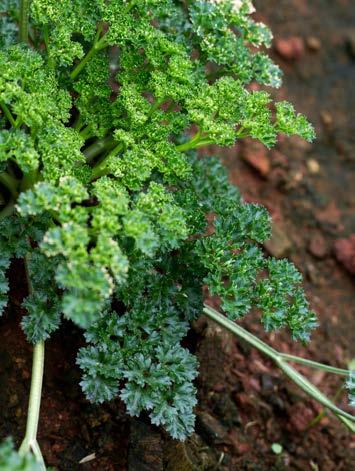
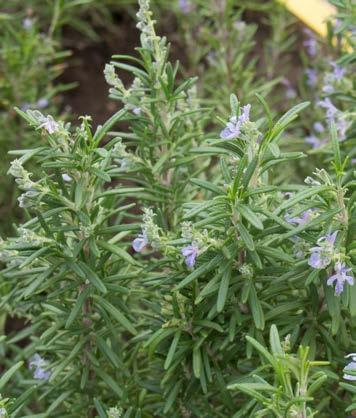

NOTE: This information is for educational purposes only, and not intended to diagnose, treat, cure, or prevent any disease. This information has not been evaluated by the Food and Drug Administration.

Violet Leaf: Calming to the skin for eczema, psoriasis, and bug bites. Helps relieve dry cough and relieve congestion. High in carotene and Vitamin C. Great in a wild salad, tea or as a poultice.

EDIBLEMADISON.COM 37
Thyme Leaf: Used as an antiviral, antifungal, antiseptic, and good for coughs, bronchitis and sore throats.
Parsley Leaf: An antioxidant, diuretic and carminative, promotes urinary tract health.
Red Clover Blossoms: A highly
Rose Petals: These are anti-inflammatory and can be used to treat wounds, bruises and rashes.
Rosemary Leaf: Prized anti-microbial, used as a mood and memory booster.
by Dylan Bruce

38 • FALL 2020 BUILDING F OOD RES i L i ENCY i N A PANDEM i C-CHALLENGED WORLD ROOTED
A s COVID-19 shifted from a distant threat on the news to a reality of everyday life, our nation experienced a shock of looming food insecurity that resulted in unprecedented and resurgent interest in gardening, and rising demand and pressure on food banks. Here in Madison, Community Groundworks and the Center for Resilient Cities have underpinned efforts to increase food resiliency and reconnect residents with gardening. The two organizations merged earlier this year to form Rooted, which has, as they put it, “a new name and a new look, but remain[s] the same organizations you have come to know over the past twenty years in your neighborhood, at your farmers market, in your schools, and where you garden.” As a small grower with a deep interest in how to put an end to food insecurity, I caught up with Marcia Caton Campbell, Rooted’s Executive Director, to ask how the merger—and a global pandemic—have affected these two well-loved organizations.
Campbell, formerly Executive Director of the Center for Resilient Cities, explained to me that the two organizations had always worked closely together. Center for Resilient Cities was partly an urban land trust that helped to hold the agricultural easements and conservation lands at the Troy Farm site, a staple of Madison urban agriculture and food systems education. Center for Resilient Cities also founded and owned the Badger Rock
Neighborhood Center, where CRC contracted Community Groundworks to provide farm staff and training. As Campbell said, the two “worked for many years as essentially sister organizations with dovetailing missions.”
Between 2018 and 2019, the boards of each organization discussed the possibility of merging. The entire staffs of the two organizations were first brought together at a YWCA training on Racial Equity and Inclusion in January 2019. Campbell noted that while they brought together both staffs as a chance to meet each other, they also really wanted the potential new organization “to be grounded in racial equity and inclusion,” including a deep assessment of how their previous organizational structures might enable or inhibit that work. A year later on January 1, 2020, the two officially merged to become Rooted. “The work goes on uninterrupted,” Campbell told me. “Everything just kind of slotted together very neatly… Similar missions, commitment to urban ag, racial equity anwd inclusion, the work that we had done for a long time. It made a tremendous natural fit.” Yet the new organization of Rooted had barely undertaken their initial strategic planning process when the COVID-19 pandemic became a harsh reality. Campbell put it eloquently and succinctly: “We were now one and this was an extraordinary challenge that we needed to rise to.”

EDIBLEMADISON.COM 39 ROOTED
With seeds barely started for their normal season, Rooted decided to double down…
With seeds barely started for their normal season, Rooted decided to double down on vegetable production for community food security, and increased the production area at both Troy Farm and Badger Rock by over 50 percent. They also doubled the number of community garden plots at Badger Rock and took their normal education programming virtual in hopes of reaching more families in their homes. Previously in-person gardening and cooking classes are now offered via Facebook Live, and are banked there for community members to continue to enjoy and learn from. Similar videos are posted to their YouTube channel. While the staff hope to connect with learners in person soon, there has been a very positive response to the virtual classes, and they plan to continue offering them even after the current pandemic has subsided.
Rooted also helps manage a network for “farm to early care and education” programs which include the Wisconsin School Garden Network, a Gardener-in-Residence program that provides unique instruction at Grow Academy (see our September 2015 article about this amazing alternative to juvenile corrections), and The Gardens Network, which connects Madison residents with community garden space and resources. These programs are also supported by partners such as UW-Madison’s Environmental Design Lab and the City of Madison.

Campbell pointed out that the revival of interest in Rooted’s gardening programs after COVID-19 came about “for lots of reasons: because it supplies food but also because it is really good for mental and physical health, and it’s also nice to see other people (masks on of course). Just to know there are people three plots over.” Badger Rock has also become an aggregator of sorts, helping facilitate the transfer of much needed food to hundreds of area families alongside partners such as Community Action Coalition and REAP Food Group. The food produced at Troy Farms includes 85 CSA shares provided free of charge to local families battling food insecurity. Community members can also purchase shares annually, and find produce at their farmstand and the Northside Farmers Market. I’ve loved all the interviews I’ve done for Edible Madison, but this one brought some tears to my eyes. We all know these are unprecedented times. Campbell and I, alongside so very many others in our community, are in some ways fighting the same battle against COVID-19 and food insecurity from different positions: myself as one very small grower among many struggling to find markets with normal supply chains disrupted, and Campbell spearheading an organization that helps get food and the skills to produce it where they are most needed. I asked Campbell if the pandemic had brought about any long-term changes for this

40 • FALL 2020
What we really want to do is create this continuum of garden and farm-based education so that someone can follow it on through college or into their own backyards.
new organization, and she pointed to an effort alongside Michael Fields Agricultural Institute and UW-Madison’s School of Urban Agriculture to bring programming to Madison high schools. “We have food system education from preschool through middle school, but then we have this gap because none of the high schools have urban ag programs, or agriculture programs at all,” she said. “One of the things we are focusing on is filling that gap… What we really want to do is create this continuum of gardenand farm-based education so that someone can follow it on through college or into their own backyards.”
As a young, white, male farmer privileged to follow the continuum of my own family farm, that one hit home. But it was what she said next, when I asked if she had one takeaway for the reader, that really got the tears welling up and prompted me to make a speedy end to the interview: “As an appeal to folks,” she said, “if you’ve got some disposable income, support your local farmers, your local food banks, and figure out where you fit in the food system response to the pandemic to make sure that everyone gets fed. Plug in anywhere. Your time is helpful, even if it’s just doing lastmile food delivery.



“The business of working to relocalize the food system is more important now than ever, and there … are a myriad ways you can plug into this food system to keep it functioning healthily and actually rebuild it. Find the place in the food system that moves you, that you have a passion for, and jump in. Because we need you.”



EDIBLEMADISON.COM 41
good. local. food. 609 N. Main St. Viroqua Everyone is welcome to shop! Certified organic local hemp oil grown by a local farmer. SMALL BATCH SINGLE ORIGIN HAND HARVESTED Order now at wilocalhemp.com








42 • FALL 2020 MARKETPLACE
& FARMERS MARKETS
VIROQUA
FOOD CO-OP
609 North Main St., Viroqua 608-637-7511 viroquafood.coop
WILLY STREET CO-OP
Willy East: 1221 Williamson St., Madison 608-251-6776
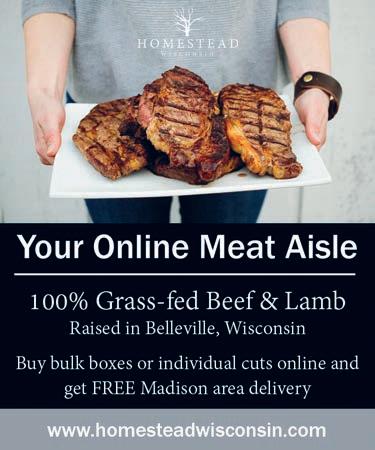
Willy West: 6825 University Ave., Middleton 608-284-7800
Willy North: 2817 N. Sherman Ave., Madison 608-709-5445 willystreet.coop
THANK YOU TO OUR ADVERTISERS!
Please support the following businesses to experience the best local, seasonal, and sustainable products and services in the region.
BUSINESS & CONSUMER SERVICES
BOOKKEEPING WITH COMMON CENTS
608-498-0292 bookkeepingwithcommoncents.com HEARTLAND CREDIT UNION heartlandcu.org
KAREN INNIS Century 21 Affiliate 608-799-1338
CATERING
ROOTED SPOON CULINARY
219 S. Main St., Viroqua 608-632-2120 rootedspoon.com
KITCHEN & TABLETOP CONVIVIO
122 North Lexington Street, Spring Green convivioshop.com
POSTKNIFE 608-285-2623 postknife.com
FARMS & FARM GOODS
Homestead Wisconsin Belleville 608-712-0997 homesteadwisconsin.com
FOOD, AGRICULTURAL & SUSTAINABILITY ORGANIZATIONS
COOK IT FORWARD cookitforwardmadison.com
FAIRSHARE CSA COALITION
303 S. Paterson St., Ste. 1B, Madison 608-226-0300 csacoalition.org
REAP FOOD GROUP
306 E. Wilson St., Ste. 2E, Madison 608-310-7836 reapfoodgroup.org
SLOW FOOD-MADISON slowfoodmadison.org

SUSTAIN DANE
211 S. Paterson St., #200, Madison 608-819-0689 sustaindane.org
VALLEY STEWARDSHIP NETWORK
124½ South Main St., Viroqua 608-637-3615 kickapoovsn.org
FOOD & BEVERAGE
THE CIDER FARM
8216 Watts Rd, Madison 608-217-6217 theciderfarm.com
EMMI ROTH CHEESE 657 2nd St., Monroe rothcheese.com
GIANT JONES BREWING COMPANY
931 E Main Street, Madison giantjones.com
ISLAND ORCHARD CIDER 12040 Garrett Bay Rd., Ellison Bay 920-854-3344 islandorchardcider.com
MADISON SOURDOUGH 916 Williamson Street, Madison 608.442.8009 madisonsourdough.com
ORGANIC VALLEY 1 Organic Way, La Farge 888-444-MILK organicvalley.coop
PASTURE AND PLENTY 2433 Old University Avenue Madison 608-665-3770 pastureandplenty.com
THE QUINCE & APPLE COMPANY 608-301-5433 quinceandapple.com
RALEIGH’S HILLSIDE FARM 901 N Marsh Rd, Brodhead 608-451-2467 raleighshillsidefarm.squarespace. com
WONDERSTATE COFFEE
1201 North Main St., Viroqua 608-637-2022 wonderstatecoffee.com
EVENTS
WORMFARM INSTITUTE
PRESENTS: FERMENTATION FEST September 26-October 4 fermentationfest.com
EDIBLE STARTUP SUMMIT November 9 -10 https://fyi.extension.wisc.edu/ediblestartup
EDIBLEMADISON.COM 43





FALL 2020 Every purchase you make will help a community continue their work in telling the story of local food. 80+ RECIPES PHOTOGRAPHS, PODCASTS, VIDEOS AND COOKING ILLUSTRATIONS From the makers and advocates of local, sustainable food in Edible communities everywhere. A COOKBOOK TO BENEFIT THE PUBLISHERS OF EDIBLE COMMUNITIES www.ediblecommunities.com/edible-cookbook RECIPES FOR HOME Download our Benefit Cookbook today for $20


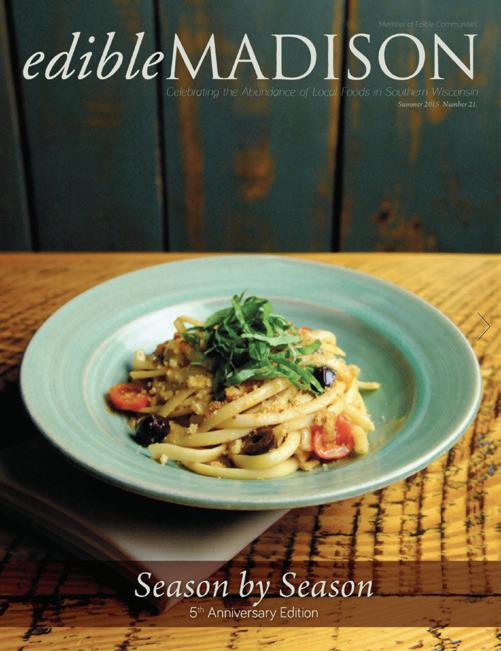




Join
Get every issue of mailed right to your door!
a community of eaters who are passionate about the health of our foodshed. Your donation supports your local food system.
Photos by Tracy Harris
Chefs Itaru Nagano and Andy
Patrick Sierra opened Fairchild on Monroe Street in Madison this past March 2020. Chef Itaru discovered produce from a self-described ‘No Name Farm’ at the Westside Community Market early in the growing season. This fall, after 20 years of farming, the folks at ‘No Name Farm’ announced a new name: Forenoon Market. Jewel-like raspberries from Forenoon adorn the beignets, served with chocolate sauce, thinly sliced jalapeno and cilantro. Dessert is not to be missed at Fairchild. Dine in or order to go. Welcome to the neighborhood, Fairchild. We’re so glad you’re here.
 Kroeger with Sommelier
CHRISTY MCKENZIE
Kroeger with Sommelier
CHRISTY MCKENZIE
LAST BITE















48 • FALL 2020




































 JESS i CA JONES
JESS i CA JONES










 Recipe by Lauren Montelbano of The Vibrant Veg
Recipe by Lauren Montelbano of The Vibrant Veg



































































 Kroeger with Sommelier
CHRISTY MCKENZIE
Kroeger with Sommelier
CHRISTY MCKENZIE













